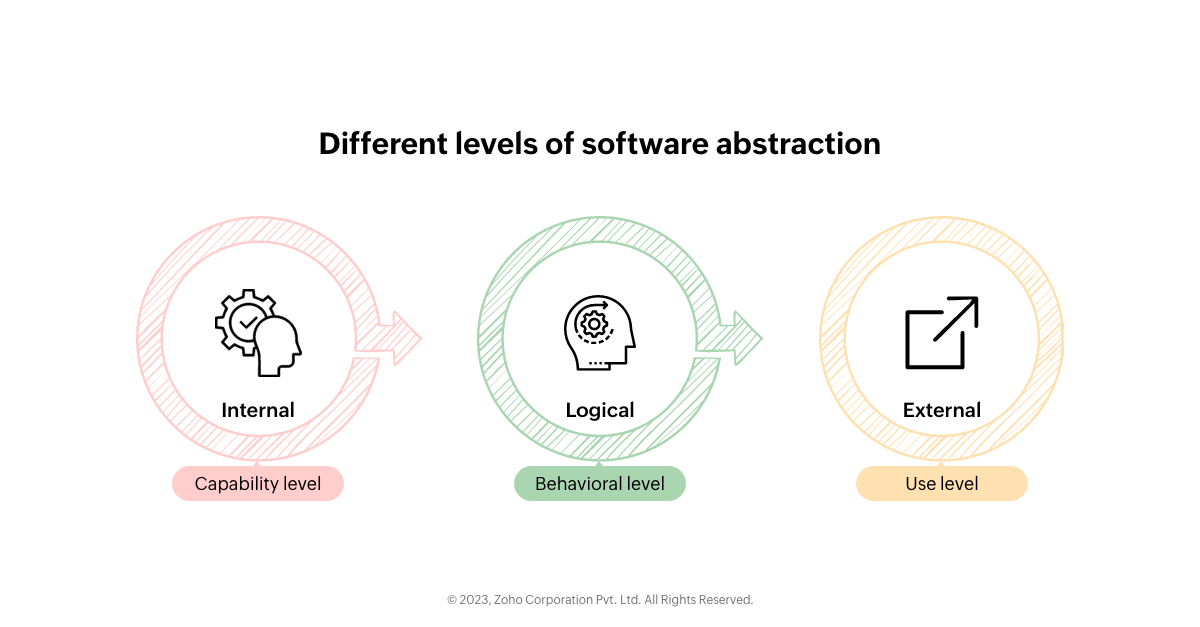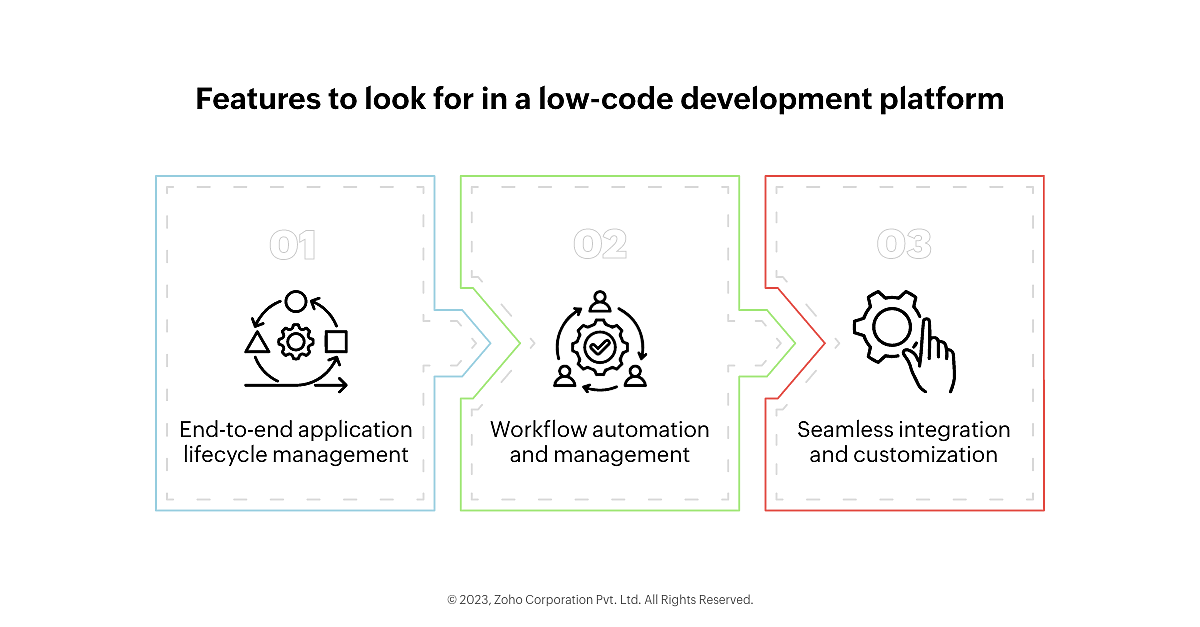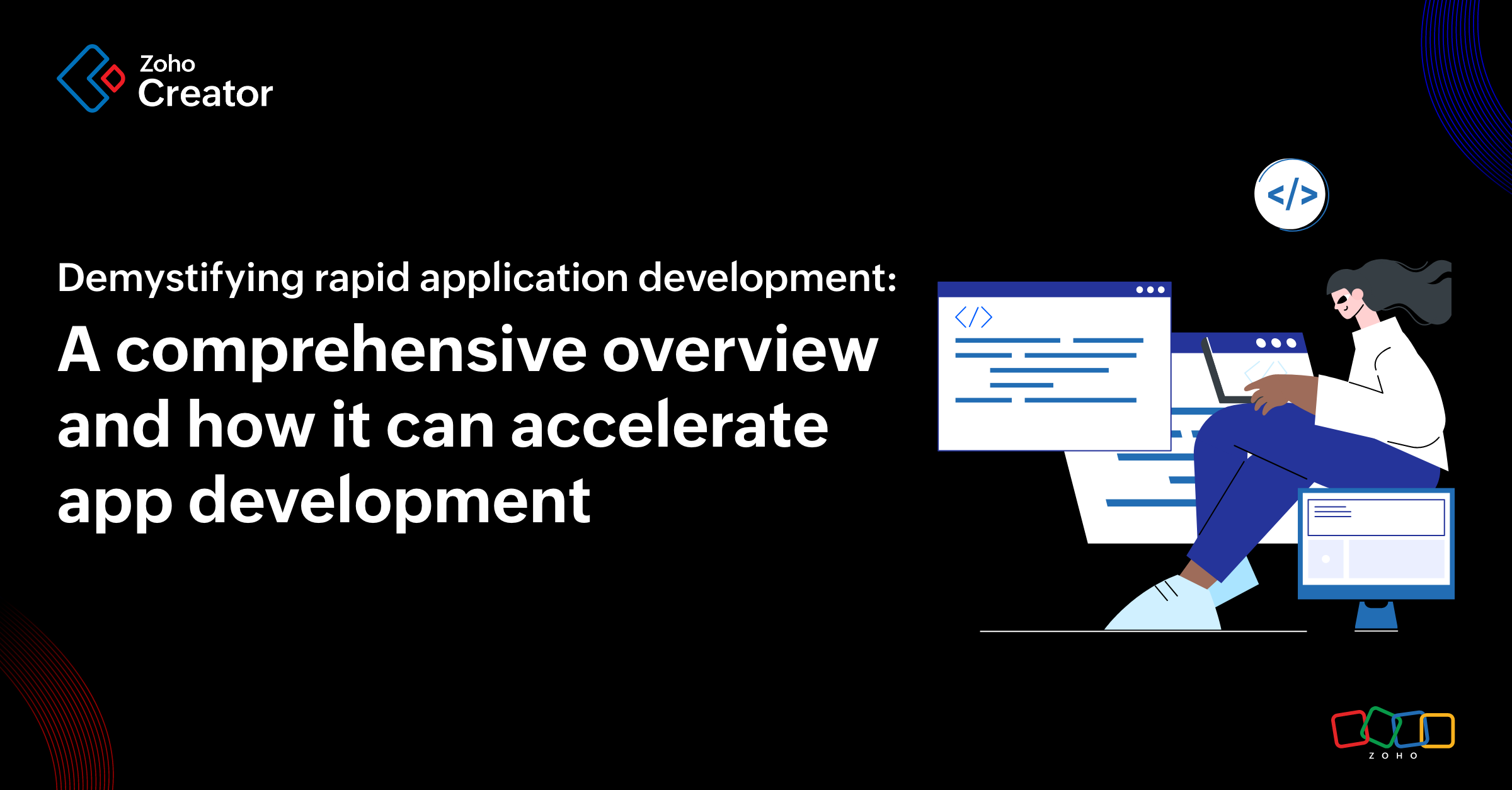- HOME
- Know Your Tech
- No-code vs low-code: What are the key differences?
No-code vs low-code: What are the key differences?
- Last Updated : August 25, 2023
- 8.6K Views
- 6 Min Read
Low-code platforms have a proven edge over traditional application development systems in today's dynamic business world, where agility is often synonymous with success. But in the context of business applications development, what is the low-code vs. no-code battle all about? And when should you select one platform type over the other?
While some perceive no-code (NC) as a more advanced alternative to low-code (LC), others believe that there's little to no distinction between the two, with no-code often written off as a marketing spin on a decade-old process. To determine which perception is most accurate, we must first look at what low-code and no-code platforms were originally conceived to be, and how they've evolved since.
What is a low-code platform?
Low-code platforms are built to democratize the software development process. Many low-code platforms provide users with drag-and-drop capabilities, pre-built templates, and seamless integration capabilities, so they can build apps without possessing advanced programming skills. These platforms also enable users to heavily customize their applications with the help of scripting languages that are similar to English. Non-professional developers can use low-code platforms to create apps tailored to their business use cases, while professional developers can leverage their coding knowledge to build core business systems.
What is a no-code platform?
As the name suggests, no-code platforms, or zero-code platforms, are technology platforms that require no coding knowledge at all to create applications. Similar to low-code platforms, a no-code platform enables rapid business application development. No-code platforms are primarily built for business users who want to create apps that meet their team or function's workflow automation needs. No-code tools, like drag-and-drop UI functionality and workflow logic builders, are common across platforms. These platforms simplify the software development process to a great extent, enabling users with zero coding expertise to quickly put together fully-functional business apps, supporting their organization's digital transformation.
Low-code and no-code: A look back
Though the current iteration of low-code development platforms has been around for over a decade, the principle behind the platforms has actually existed much longer. If you have an IT background, chances are that you've stumbled upon low-code platforms in one form or another, either as a high-level programming language (4th or 5th generation) like Perl, Python, and SQL, or a derivative of computer-aided design and software development tools, which were popular in the 90s. All of these work on a common premise—what Gartner defines as “high-level programming abstractions.” Put simply, Gartner is referring to the ability of low-code solutions to hide complexities (i.e. thousands of lines of code) and show users the bare essentials.
Abstractions, in a low-code/no-code development context, are generally represented at three levels: the internal/capability level, logical/behavioral level, and external/use level. It helps to understand each in brief, as the levels provide key points of differentiation between low-code and no-code platforms:
Internal/capability level: The fundamental capabilities of a development platform and what can be achieved through them. For a low-code/no-code (LC NC) platform, this includes the set of tools and out-of-the-box functionalities offered, and the degree to which these can be customized to suit your business process needs.
Logical/behavioral level: The business functionalities of the application, or the manner in which different aspects and tools are integrated and made to function in a meaningful manner. This includes built-in automations, workflows, and both custom and out-of-the-box integrations with other business applications.
External/use level: Everything that is produced as a result of the application's usage. This includes short-term processing changes, as well as the data collected and stored throughout the application's life.

How do no-code and low-code development differ?
Many see low-code development as a visual approach to creating applications that empower business users to build, test, manage, and deploy applications without traditional programming methods. Low-code and no-code platforms achieve this by offering ready-to-use code blocks (collections of code for specific functionalities) that can operate within predefined constraints through a simple drag-and-drop interface.
For instance, if you'd like to trigger a workflow when a certain set of actions are performed on your app, you could either use a programming language, like Python, or low-code/no-code platforms that have already configured the set of actions into code blocks that the machine can easily read and interpret.
Now, imagine there are three standard conditions upon which these workflows will be triggered. No-code platforms would factor these into their code blocks and train the platform to detect and trigger the workflows when any of the three conditions are met. But what if you'd like to include two additional conditions that are unique to your business environment? No-code platforms, which have traditionally been designed to enable rapid application development (RAD) through zero programming, would not be able to help you here.
Enter low-code development platforms (LCDP). In addition to factoring in the three standard conditions, low-code development platforms would also give you the means to create new and unique conditions. LCDPs achieve this without straying from their central premise of empowering business users and citizen developers to create apps and configure workflows, though different platforms approach this goal in different ways. While Microsoft PowerApps uses a variant of DAX, Zoho Creator uses its own proprietary and highly user-friendly programming language, Deluge, for customizations.
When to opt for low-code over no-code platforms?
Both low-code and no-code solutions were conceived to boost business agility and effectiveness, but they serve different segments in different ways. While no-code platforms have evolved rapidly to cater to the needs of micro, small, and medium-sized enterprises (MSMEs) and solopreneurs, their more customizable counterparts (low-code development platforms) have come to cater to enterprise needs as well, complimenting increased enterprise SaaS adoption.
Businesses opt for no-code platforms to build simple applications that act as a standardized front to their end users, with low functional capabilities and customizability. Consider a situation where you'd like to deploy a simple post-event management app that collects feedback from participants and displays the results as a dashboard. In this case, no-code solutions might be just as capable as a low-code alternative.
But if, in addition, you'd like to selectively route users belonging to different satisfaction brackets to different teams to take further action, conditionally trigger responses, add users to different nurturing flows, or even push the feedback data to your CRM, you'd realize quickly that no-code platforms are not your ideal option.
Simply put, you must factor in your business' long-term digital aspirations when selecting an app development platform. If you want simple, standardized, one-off applications, primarily for front-end needs, a no-code platform is the way to go. Looking for something more? Maybe reconsider (and read on).
Key features of a low-code platform
So, what are the key features that make low-code platforms better for building enterprise-grade applications?
End-to-end digitalization: A low-code platform supports the entire application lifecycle, from organizing and managing your business data and modeling your application's architecture to development, testing, deployment, and performance management. And it's all on the go, making it relevant for both professional developers and citizen developers alike and leaps ahead of no-code development at the capability-level of abstraction.
Comprehensive workflow management: Low-code platforms often provide a visual workflow editor with a simple drag-and-drop interface, like no-code, but with room to configure more advanced automated workflows. LC platforms often double as business process management (BPM) platforms for optimizing operations.
Integrations and customizability: Low-code app development platforms can be seamlessly integrated with any third-party applications and customized to suit your business processes with little or no coding. In addition to advanced automation, this feature makes low-code platforms a clear winner in the logical/behavioral layer of abstraction.

Looking forward
Low-code is the most disruptive force in application development today, having empowered millions of non-technical leaders, professional developers, and businesses. In the years to come, low-code platforms will continue to expand their integration ecosystems, incorporating standard sought-after functionalities into ready-made code blocks. Vendors will also focus on bringing more software developers into the fold to foster greater collaboration, enhance component reusability, and facilitate smoother hand-offs.
Meanwhile, a few no-code platform developers have already begun seeing the value in increased UI and reporting customization capabilities, improved functionality, and easier integrations. Many have consequently built low-code-like workarounds to help users achieve these results, while still positioning themselves as no-code.
With the low-code market predicted to grow to $45.5 billion by 2025, one can expect both models to swiftly evolve and adapt to market needs, making the low-code/no-code development battle one to watch!
Zoho Creator and low-code application development
Conceived and launched more than a decade and a half ago, Zoho Creator was an early entrant in the low-code development space and continues to be a strong innovator. Creator has evolved to support you through the entire application development lifecycle, from data management, architecture, and modeling to deployment and performance management, with the option to do it all without coding.
With 60+ prebuilt applications catering to multiple industry sectors and business functions, Creator gives you a time-tested framework and custom apps to get started with. Creator's intuitive drag-and-drop interface lets you create apps quickly, while its easy-to-learn and user-friendly programming language helps you configure advanced automation, establish deep integrations with third-party systems, and fully customize your applications!
 Ram Srinivas
Ram SrinivasRam is a product marketer for a couple of products incl. Zoho Creator. He is an avid SaaS and automation enthusiast. In his spare time, he likes indulging in war novels, motorcycling or strumming away on his ukulele.



